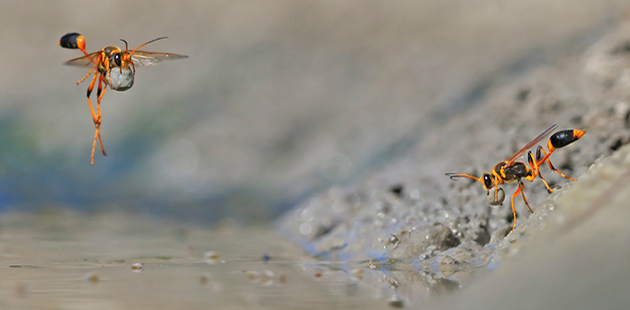 On loan from London’s Natural History Museum, the largest wildlife photography competition in the world, Wildlife Photographer of the Year, has opened at the Australian National Maritime Museum.
On loan from London’s Natural History Museum, the largest wildlife photography competition in the world, Wildlife Photographer of the Year, has opened at the Australian National Maritime Museum.
100 breathtaking photographs have been shortlisted from over 50,000 entries from 92 countries, and celebrate the diversity of the natural world, from intimate animal portraits to astonishing wild landscapes. The competition has grown exponentially from its launch in 1965 which saw 361 entries.
“We are thrilled to be launching this popular and innovative exhibition here in Australia,” said Kevin Sumption, Director of the Australian National Maritime Museum. “One of the Museum’s main objectives is conservation of our beautiful marine ecosystems and this competition raises awareness about the beauty and the fragility of the natural world.”
“This is one of the most prestigious photography competitions in the world and we are delighted that Sydney audiences can once again enjoy these unforgettable and inspiring images at the Australian National Maritime Museum.”
For more than 50 years, Wildlife Photographer of the Year has championed ethical wildlife photography while pushing boundaries of artistic freedom, narrative excellence and technical skill. Winning images are selected for their creativity, originality and technical excellence.
2019 sees five Australians in the finals: Georgina Steytler, Mud-Rolling Mud-Dauber (Winner, Behaviour: Invertebrates); Justin Gilligan, Dinner for Two (Highly commended, Behaviour: Invertebrates); Robert Irwin, The Catch (Highly commended, 11–14 years old); David Gallan, Home of the Quoll (Highly commended, Animals In Their Environment); and Wayne Jones, Glass-House Guard (Highly commended, Under Water).
Georgina Steytler: Mud-Rolling Mud-Dauber
Georgina was at the waterhole early to photograph birds, but her attention was diverted to these industrious wasps. They were busy at the water’s edge, rolling the soft mud into balls and carrying them to their nearby nests. For a good angle, she lay in the mud, then pre-focused on a likely flight path and began shooting continuously.
The female mud-dauber wasps use the mud balls to build their nests. Collecting them into clusters, they then carve chambers inside the balls into which the females lay their eggs. Before closing each one up, the wasps insert the paralysed bodies of orb-weaving spiders as food for their larvae when they hatch.
Justin Gilligan: Dinner for Two
Justin spotted these hungry blue dragons closing in on a by-the-wind sailor in a rock pool, and wanted to capture this “different layer of life in the ocean”. He used an underwater torch to light his shot from beneath, and framed their elaborate forms from above, against a galaxy of reflective particles.
Blue dragons are small sea slugs that float upside down buoyed by air bubbles in their stomachs. They feed on cnidarians, a group of marine animals that includes jellyfish and this by-the-wind sailor. Storing stinging cells from their prey in finger-like protrusions, the blue dragons use this venom to defend themselves against predators.
Robert Irwin: The Catch
Robert was trudging through dense woodland at night when he saw the huntsman spider, dangling in mid-air, clutching a dead frog. “It was fascinating to see it manipulating the frog with its front legs while gripping it with its fangs,” he said. “To see it predating an animal so large was extraordinary.”
Huntsman spiders don’t build webs. Instead they hunt their prey, usually stalking large insects and other spiders, but also occasionally frogs. This one probably fell off a branch while struggling with the frog, and was left hanging dramatically from a silk anchor line. It had set this up as a precaution against such an event.
David Gallan: Home of the Quoll
It took David three years to locate this quoll – and another six months to take this photograph. He set up a camera trap where a fallen log bridged a stream, foregoing flash to minimise disturbance, then placed a scent bait to pause any passing quolls. His perseverance paid off when this hunting female scampered into view.
These shy creatures are ferocious predators. Almost a metre long from nose to tail, quolls can slice meat off the reptiles, birds and mammals they hunt with their strong teeth and muscles. Like all quoll species, the spotted-tailed quoll is threatened by habitat loss due to industrial logging and competition with introduced species.
Wayne Jones: Glass-House Guard
A yellow pygmy goby floats inside its human-made home: a discarded bottle lying on the seabed. Wayne set up his camera a few centimetres from the bottle’s narrow opening, and focused on the goby’s arresting, bulging blue eyes. The movement of the fish blurred the rest of its features into a haze of yellow.
Usually found in breeding pairs, the tiny and colourful yellow pygmy goby often inhabits old worm holes or empty bottles or cans. In this temporary home, the female lays several batches of eggs, while the male takes on guard duty to defend its spawn from intruders. Plastic is an increasing feature of its marine environment.
“Wildlife Photographer of the Year is one of our most successful touring exhibitions, enjoyed by millions of people all over the world,” says Sir Michael Dixon, Director of the Natural History Museum. “The awarded images shine a spotlight on nature photography as a work of art, whilst raising questions about our crucial role in shaping a sustainable future.”
Wildlife Photographer of the Year
Australian National Maritime Museum, 2 Murray Street, Darling Harbour (Sydney)
Exhibition continues to 25 August 2019
Admission fees apply
For more information, visit: www.sea.museum for details.
Image: Georgina Steytler, Mud-Rolling Mud-Dauber, 2018 (detail) – courtesy of the Australian National Maritime Museum
